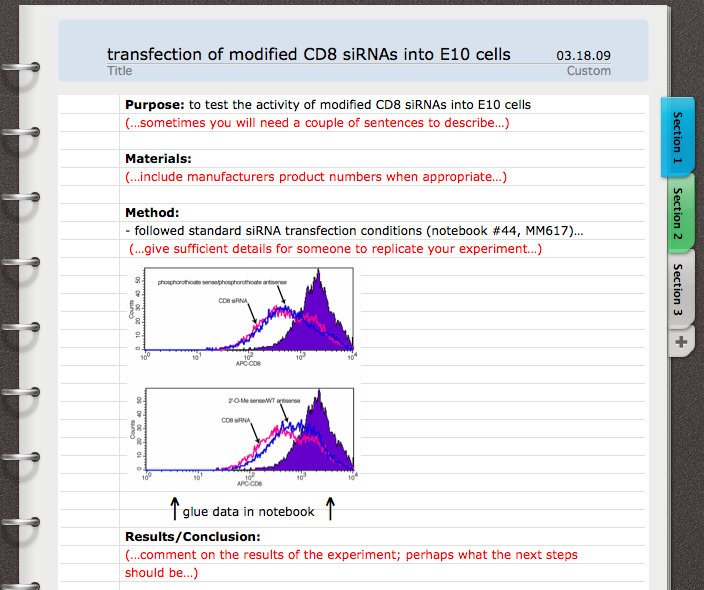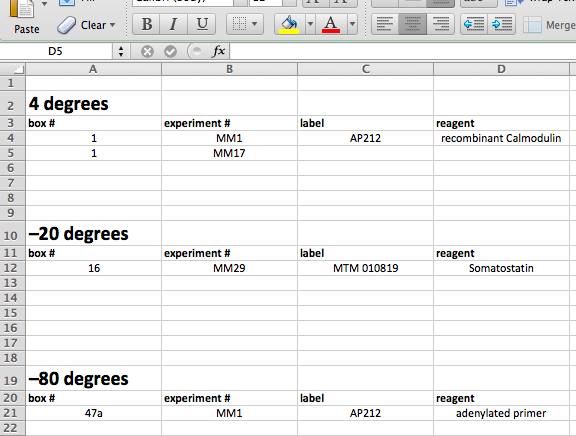McManus Lab Notebook Policy
Need a notebook? We maintain electronic notebooks (ELNs) in the lab. Your Box Account contains a directory with templates to help you get started. The below text contains some guidance, noting that the images are from our older paper-centric notebooks. The overall essence is the same: all data must be recorded, no matter the results.
Our lab has a standardized system for allowing the efficient retrieval of data now and in the future. The critical issue is to ensure that our results can be reproduced at any time in the future and that we have traceable records. These guidelines apply to all lab trainees and staff, no exceptions. If you are unclear on any of these guidelines, and wish see examples of properly formatted notebooks, please ask. All Labbies are expected to keep an electronic notebook, synced in the Lab Box. A rough example format for a standard notebook entry is shown below and a more granular example can be downloaded here. Each entry is stored within its own directory, labeled according to the experiment number. And within each directory, subdirectories contain raw data of varying file formats. Do not maintain a single word document containing all experiments. To help you, your Box contains a pre-organized hierarchical structure.
Because Box is a managed, access-controlled system that provides file version history, modification timestamps, robust backups, and admin/audit capabilities (e.g., who accessed/changed content and when), it satisfies standard “audit trail + retention + integrity” expectations expected for ELN-style records, especially when paired with a consistent notebook structure. For these reasons, UCSF has approved our laboratory use of standard text documents (eg Microsoft Office) in Box. This is our ELN.

1) A simple chronological record for each experiment should be kept, following UC directed guidelines. To facilitate tracing and retrieval of data in the future, all lab members should apply the following convention for entry of experimental results in lab notebooks and storage of original data:
a) Your eNotebook directory must contain index (table of contents). The table of contents contains the experiment number (ie MM24, see below), title, and date. This index should be completed at the same time of entering data in the notebook and located in the same directory.
b) Every experiment be given a separate, sequential identification number identified by the investigator's initials followed by a number. For example- MM24 would be Michael McManus's 24th experiment. His next experiment would be MM25, MM26, etc. All data associated with the experiment will be labeled in the same manner. Once you get in this habit, you will find that it makes your life easier and protect valuable samples. Likewise, all tubes and reagents associated with that specific experiment would get the "MM24" code, which makes it easier to decipher refrigerator and freezer items. You can use this code to help populate a database- so that when you depart- we will be able to maintain and use your valuable items and connect it with data used in publications. For example, here is a reagent spreadsheet:

c) For each experiment, give it a SHORT TITLE at the top of the page to identity the nature of the experiment (for example, Cloning the hPGK promotor into pSico-mCherry).
d) Enter the DATE the experiment was started and sign the page. Next give a brief description of the PURPOSE of the experiment (even if it seems implicit from the short title). One or two carefully worded sentences should be sufficient.
e) Give the MATERIALS used, and outline the METHOD to be used. If it is a standard technique (e.g. FACS staining, SDS-PAGE analysis, agarose gel electrophoresis, etc.), it is only necessary to state the method and condition variables or refer to an SOP that you place in your Lab Protocols directory. For example, for restriction mapping a plasmid, it is only necessary to record the reaction components and concentrations, digestion time, and % agarose gel used; a detailed description of the procedures is unnecessary since this is a standard technique in the protocol manual. If the method is new or there is substantial modification to a standard method, these must be described in detail to ensure that another investigator could repeat the experiment.
f) Whenever possible-- enter the raw experimental results in the e-notebook. For example, the photo of an EtBr-stained agarose gel can attached into the e-notebook document. However, in rare cases this may be impractical for some types of results, in which case the raw data may be stored elsewhere (but its exact location must be referenced in the e-notebook and the data must be stored in a properly backed-up archive server). Examples include troves of deep sequencing data, which are stored on our Centaurus lab server or our Petabyte server.
g) For each experiment, the RESULTS and CONCLUSION should be stated in the lab notebook. This does not have to be extensive, but should simply summarize whether the experiment was successful and the major finding. For example, in a FACS experiment to screen for new cell lines expressing CD45 in 293 cells, the conclusion might be "7 possible CD45(+) 293 lines were identified" or "no positive cell lines produced." Please get in the habit of including the NEXT STEPS section-- which can be immensely valuable in helping the reader tp string together your notebook entries.
2) Often you will be working on several experiments in a single day. I have found that it is helpful to always start at the top of a new notebook page for every experiment. For example, in a single day you might be screening cell lines by FACS, restriction mapping a plasmid, and performing a Northern blot. These would be given three different experiment numbers (e.g. MM48, MM49, and MM50) and each would begin on a new notebook page.
3) A table of contents must be kept in a consistent format in the front of every lab notebook. This is illustrated in the following example:

Keep in mind that the lab notebook does not belong to you or even the lab-- it is the property of UCSF. It should not be taken off campus without permission. At any time, UCSF legal may confiscate the notebooks to evaluate the validity of our patent claims, or even reports of unethical practice. Take your notebook seriously!

